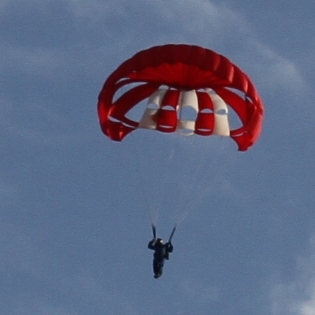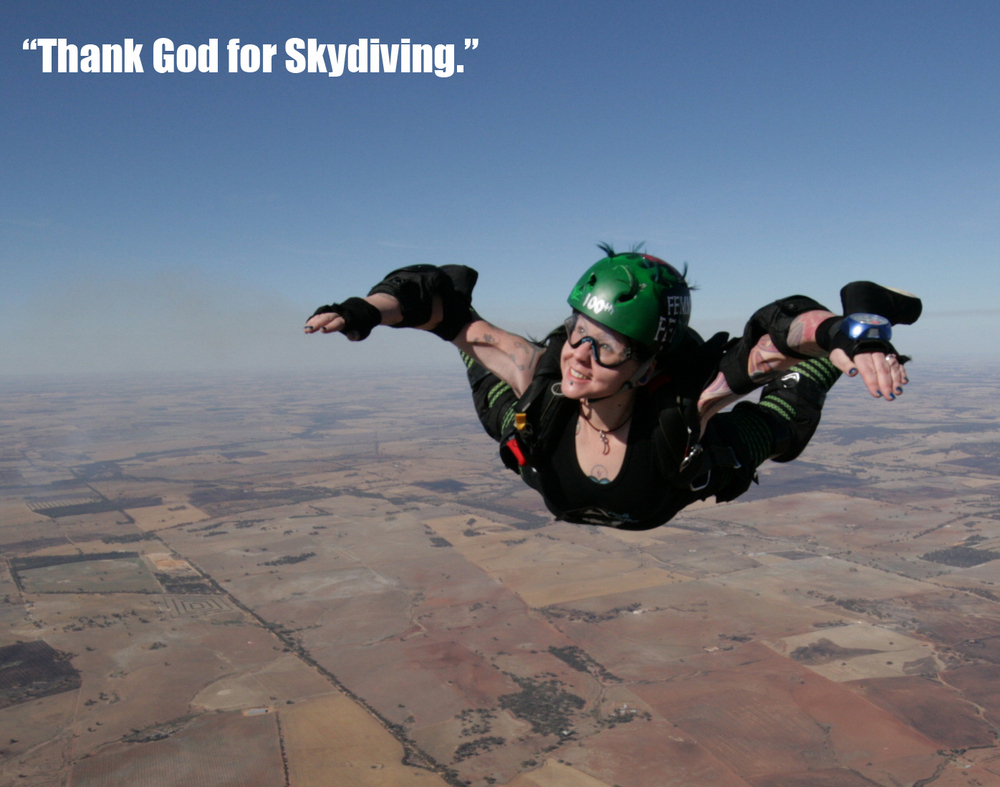Recommended Posts
Beatnik 2
Going to the Bill Booth comment earlier. I completely believe the guy is a salesman. He has a team of engineers that he has intellectual rights over and when they invent something he can claim it as his own. Last I checked in the FAA database he still isn’t a rigger but since he is a manufacturer he can get around that. Regarding the Vector reserves taking forever. Well, I don’t know about that but they certainly aren’t as fast as many other containers. The no mesh pilot chute has a really low coefficient of drag and from what I have witnessed it takes longer to obtain the force required to extract everything. The Racer pilot chute uses a large mesh and does have a higher coefficient of drag compared to most.
The Racer pilot chute does have a large coefficient of drag and that helps a lot with the reserve deployment. The other thing that is nice about the Racer is the reserve bridle. Being made out of Type IV 3” webbing has to increase the drag compared to the 2” bridles many manufacturers use.
With the closing flaps and closing loops. As Rob said the Racer loops have to clear more grommets than others but the forces that are applied are more direct than other containers. Since the closing loops are connected to the pilot chute it is being pulled directly through them where as other containers have the pilot chute pushing flaps and have the closing loop zig zaging back and forth through the grommets and then through the pilot chute.
You could also take into the equation the stiffness of the flaps as well. Stiffer heavier flaps should require more forces than lighter ones. Most manufacturers use 1000 denier cordura opposed to the 500 denier that Jumpshack uses. But that has its prices as well since 1000 denier is so much tougher than the 500 denier.
You could look at the cypress cutter configuration on the Racer and have some concerns. I believe there was a pretty major incident recently about a AAD cutter not cutting the closing and causing the whole system to fail. The Racer does require two cutters and if the situations were just right, it could conceivably not cut one reserve loop or they could lock up which would cause the whole system to fail. The chances are I am sure almost nil but there is still the chance.
Onto the rigger packing. Rob I really wish you wouldn’t try to submit your personal experiences or problems packing Racers as some kind of data. It may be your experience but that is all it is. You might be a master rigger and a CSPA rigger examiner but that means absolutely nothing as to the ease or difficultly of packing a specific container. We have had this debate before and I am not going to beat it to death again. But one person’s experience is not a large enough sample size to be considered as hard data. It may have taken you a decade to learn how to pack a Racer but it took me about two days how to pack one really well. So what does that tell you? It should mean nothing because some people are going to be able to do things better and easier than others and this applies to everything and doesn’t really mean a thing. Now if you said that it took 1000 riggers a decade to be able to pack them then it would have more meaning.
Comparing containers is like comparing makes of cars. Every make has its group of followers and convincing them to change their mind is probably not going to happen. From what I have witnessed there seems to be a lot of voodoo in skydiving and usually the people with the strongest opinions against something are the ones with the least amount of factual knowledge and base their opinion on hearsay or advertising.
When it comes to choosing a container just pick one you like. They are all very similar and I don’t believe that any one particular system is superior to another. They all have pros and cons.
So long as its only your advice right,,,![]() Simply put, its a nice rig at a very reasonable price. Thats all i was saying.....can one get a new rig cheaper ? Go back and look at my other post,,see that snicker/tongue icon ? That was put there so i could suck you in....and it always works
Simply put, its a nice rig at a very reasonable price. Thats all i was saying.....can one get a new rig cheaper ? Go back and look at my other post,,see that snicker/tongue icon ? That was put there so i could suck you in....and it always works ![]()
FB # - 1083
riggerrob 558
..."
......................................................................
I agree with the first part of your statement, but disagree with the second part.
The size and shape of plastic stiffeners can make a big difference in how much energy a pilot chute spring has to waste pushing flaps out of the way, before it can launch.
For example the stiffeners in Sidewinder side flaps are longer than the diameter of the pilot chute cap. Airtec discourages this practice because it can slow pilot chute launch.
Try to picture trying to bend a sheet of plywood by pushing up in the middle.
I disagree with your second statement because I doubt if 500 denier versus 1000 denier makes little difference in how flexible fabric is.
Now if the side flaps are short and tight (e.g. Vortex), I makes them slower to close and I suspect makes them slower to open.
riggerrob 558
Quote...
Onto the rigger packing. Rob I really wish you wouldn’t try to submit your personal experiences or problems packing Racers as some kind of data. It may be your experience but that is all it is. ... So what does that tell you? ..."
........................................................................
That I am a slow learner????
Perhaps I should have phrased that slightly differently.
I will admit to being a slow learner.
I also know that after people have struggled to learn work-arounds, their minds are often closed to any other method.
Yes, it took me more than a decade to learn how to pack Pop-Tops. The first Racer I packed contained a round reserve so old that it did not even have a diaper. I must have stared at that line stow chart for ten minutes before stowing the first line.
To this day, I still have to stare at the manual before stowing suspension lines in a Para-Cushion (despite having packed at least a hundred Para-Cushions).
The next Racer I packed contained a round reserve with a two-stow diaper. That included its own learning curve.
Then square reserves came into fashion. The first square reserve that I packed into a Racer was a Hobbit with a diaper. ... another learning curve.
Then Racer introduce freebags. I bought a set of fancy steel T-bodkins (the type with the sliding sleeve) when they broke the first time I tried to close a Para-Cushion, I cursed and threw them in the trash. %$#@!
Then I struggled for another decade with simple steel T-bodkins.
When Cypres was introduced, Airtec sent along a Pop-Top packing kit that contained soft bodkins and more tools than I can count!!!!
Eventually, a german rigger told me about ghost loops, and I FINALLY understood how to close Pop-Tops. A few years later, Jump Shack started handing out free ghost loops.
To simplify tool count I finger-trapped a pair of pull-up cords to my ghost loops.
Even with ghost loops, it takes me most of an extra hour to close Racers and make them look pretty.
Beatnik 2
As for the disagreement on the stiffness of material. It might make little difference but that is what is being discussed. If you compared the two types of materials you can see the one is clearly heavier and if it is reinforced it will be tougher. It might not mean a lot but it is still there and I was just giving more information to this discussion. Really there is much more to all of these arguments than what is being discussed or being brought forward as supportive data by the manufacturers.
JerryBaumchen 1,048
QuoteTo launch a Javelin pilot chute, it needs to clear two flaps.
I think someone else also said this up-post.
Unless we count differently, I think a Jav/Wings have three flaps over the pilot chute; two coming from the top of the container & one coming from the bottom of the container.
And 'normally' a Dolphin only has two flaps over the pilot chute, both coming from the top of the container; but it can be packed with three flaps ala Jav/Wings.
Yes/no??????
JerryBaumchen
QuoteSo long as its only your advice right,,,
Simply put, its a nice rig at a very reasonable price. Thats all i was saying.....can one get a new rig cheaper ? Go back and look at my other post,,see that snicker/tongue icon ? That was put there so i could suck you in....and it always works
I ended my response to you with snicker/tongue icon as well, in case you did not notice. Best rig - whichever one works for you, gets you in the air, and gets on you the ground safely. I always try to point out that what one considers great, others may not be so happy with, that's all. Thanks for sucking (me in) !
Quote
Best rig - whichever one works for you, gets you in the air, and gets on you the ground safely. I always try to point out that what one considers great(or comfortable?), others may not be so happy with, that's all. Thanks for sucking (me in) !
Is that a data point or opinion. I think you may have finally got it right. Thank you for all of your opinions.
riggerrob 558
Reserve containers with no plastic stiffeners (over the pilot chute spring) and only Type 4 tape reinforcements on the rest of the flaps can launch pilot chute springs much quicker than containers with many wide plastic stiffeners (most other containers).
Scaling issues can also create problems. For example, Rigging Innovations found out - the hard way - that you cannot simply use the same pilot chute and ever narrower rigs, because eventually pilot chutes will hesitate before they launch. specifically, R.I. was never able to make the Talon 1 patterns work consistently with reserves smaller than 150 square feet.
R.I had to completely re-design reserve pilot chutes (Stealth) and freebags and containers before they could get Talon 2s to deploy consistently with Micro Raven 109 reserves.
Beatnik 2
Now is the plastic stiffener being stiff causing the problem or the associated weight or both? If weight is contributing to it then the above does have merit. I honestly don't have an answer and I haven't seen any real research done on it, just experiences and they seem to differ and nothing completely concrete on a wide range of things. Thinking about it some more, some old containers have had some pretty stiff reinforced flaps that don't seem to have a real issue that we are seeing with newer designs. For example the 1950's seat pack I have has metal reinforcements in some of the flaps and it launches (all ground mind you) pretty darn good IMO. So I am wondering if it is a combination of a few things with this that is really causing the issue with this case more than the individual component. These is where some solid data from research would be handy.
I completely agree with scaling causing issues. Most things that involve dynamic forces scaling doesn't work correctly. You can look at a lot of canopies for insistence, say you had a 200 sq. ft. and a 100 sq. ft. canopy. The 100 sq. ft. one would not be a perfect half scale model of the 200 sq. ft. one. There is usually a different setup to get it to fly correctly. It stands to reason other components would suffer similar issues as much other real life things do. Things seem to be very rarely linearly scaled off the drafting table.
A question with the scaling problems you have encountered. Was it the container design or the pilot chute causing the issue? The reason I ask is cause you said that you cannot use the same pilot chute on narrower rigs. So I am just trying to understand if it was the rig that was causing the issue or the pilot chute. Personally I would believe that it was the rig scaling and design causing the issue and not the pilot chute.
riggerrob 558
.........................................................................
The problem arises when you scale down one component, but not all the other components.
For example, Talon 1 were originally sold with "Talon" reserve pilot chutes with 8 inch diameter caps. Fine as long as containers are 12 or 14 inches wide.
Remember that 180 square foot reserves were fashionable when Talon 1 was introduced, but they never got that wide pilot chute to deploy consistently with containers sized for reserves smaller than 150, because they got too narrow.
Remember that many popular containers are only 9 inches across the top edge of the reserve container.
Try to picture an 8 inch wide spring trying to push through a 9 inch gap.
That is when fabric stiffness, stiffener stiffness and stiffener size become major variables.
Rigging Innovations tried switching to (Australian designed) "Skyhook" pilot chutes, the same diameter, but with much longer and stronger springs.
Eventually, R.I. switched to Magnum springs, but with caps more like 5 inches in diameter.
But with 135 reserves - and smaller - becoming popular, R.I. designed a completely new container called the Flexon, with a completely new "Stealth" pilot chute containing a long, small diameter (around 5 inches) spring that nestled into a completely new type of molar bag. The Stealth pilot chute has been incorporated into all of R.I.'s later container designs: Aviator PEP, Genera, '94 Talon, Talon 2, Talon 3, Talon FS, Telesis 2, Telesis 3, Voodoo, and whatever they call their military HALO/HAHO rig.
Wider containers (like Aviator, Telesis and HALO) do not need narrow springs, but it is too much of a hassle to stock multiple diameters of reserve pilot chutes.
Mirage also had similar problems in that 1980s vintage Arrow pilot chutes (with wide caps) did not launch gracefully from the narrower Mirages they started building in the 1990s, so Mirage bought a lot of Stealth pilot chutes from R.I. until they could design their own smaller-diameter reserve pilot chute.
Vector seems to be the only container manufacturer that has been able to retain the same (6 inch diameter) pilot chute through all the different sizes of Vector 2, Sigma, Vector 3, Micron, etc. but remember that they had to radically re-design their reserve container. Vector 2 and Vector 3 have hardly any shared parts.
Beatnik 2
Essentially the flaps on a container act like levers. With the exception of a class III lever, the mechanical advantage comes from applying forces from the furthest point from the fulcrum. When scaling it down like they were done, the forces were applied to close to it which would require greater forces to achieve the desired result. Which completely explains why a pilot chute smaller in diameter is desired to put force where it is required otherwise a complete redesign would be required to get them to function we will say more efficiently.
While I believe and can see how stiffeners can start being a variable there, as well as other things mentioned early, I think these examples show the actual design is the biggest factor more than anything else. It stands to reason if you scale down a couple of components you should do the same with the others but that is not practical in manufacturing or desirable. Looking at this specific issue, I think we are both wrong with our thoughts on this. Well at least some part of it anyways. I can see how they contribute to the issue but they are more minor factors.
jenette 0
My suggestion is buy secondhand, make sure it fits, that its not too old and has been checked over by a rigger.
It really doesn't matter which rig you choose (except don't get a Dolphin). In the first 300-400 jumps you will get good use and downsize of a secondhand container that's in good shape. When you leave college you can afford the very best and fitted to you, when you are a more experienced jumper to appreciate it. My CI says as long as it opens and does the job, any container is good, because all containers have pro and cons. Choose comfort!
I have ordered an Vector, because it was brainwashed into me by friends (peep pressure) but my first choice was a Icon. The turn around time on the Icon is 3 weeks while the vector is 22. I had to get mine built because our sport is full of tall men and not curvy women, so secondhand wasn't an option.
Buy a good secondhand rig to start. Vector, Icon and Jav are my top choices, but all will do the job ;)
Good luck.
Beatnik 2
QuoteIt really doesn't matter which rig you choose (except don't get a Dolphin). In the first 300-400 jumps you will get good use and downsize of a secondhand container that's in good shape. When you leave college you can afford the very best and fitted to you, when you are a more experienced jumper to appreciate it. My CI says as long as it opens and does the job, any container is good, because all containers have pro and cons. Choose comfort!
Can I ask why you are recommending not getting a Dolphin?
QuoteQuoteIt really doesn't matter which rig you choose (except don't get a Dolphin). In the first 300-400 jumps you will get good use and downsize of a secondhand container that's in good shape. When you leave college you can afford the very best and fitted to you, when you are a more experienced jumper to appreciate it. My CI says as long as it opens and does the job, any container is good, because all containers have pro and cons. Choose comfort!
Can I ask why you are recommending not getting a Dolphin?
I was wondering the same thing. Nothing wrong with a Dolphin.
Since she said she was brainwashed by her friends into buying a Vector, she could have also be brainwashed by the same people to believe a Dolphin is a bad choice.
Sangi 0
Quote
Can I ask why you are recommending not getting a Dolphin?
Too much velcro that wears out? Not really practical, when you have to replace it constantly (longetivity wise)...
Why would you want a mega velcro rig when you can get a normal one and use it in any discipline without any fear..
Beatnik 2
QuoteToo much velcro that wears out? Not really practical, when you have to replace it constantly (longetivity wise)...
Why would you want a mega velcro rig when you can get a normal one and use it in any discipline without any fear..
Do you even know what rig you are talking about? The Dolphins I have been packing hardly have any Velcro. So I really don't know what else to say about your post because I don't believe you know what rig you are talking about.
piisfish 135
what did you expect from Sangi ?QuoteDo you even know what rig you are talking about? ... So I really don't know what else to say about your post because I don't believe you know what rig you are talking about.
Sangi 0
Maybe the old ones had and the new ones dont?
It's somewhere I've read I think.. Sorry my bad if I made a mistake.
QuoteI thought dolphins had shit loads of velcro..
That's what you get for thinking.
QuoteMaybe the old ones had and the new ones dont?
Just like many old rigs of every brand. Many rigs use to have a lot of Velcro.
QuoteIt's somewhere I've read I think.. Sorry my bad if I made a mistake.
I have read somewhere that the earth was flat but by investigating further I found out that was old information and the earth really is round(kinda).
riggerrob 558
QuoteQuote
Can I ask why you are recommending not getting a Dolphin?
Too much velcro that wears out? Not really practical, when you have to replace it constantly (longetivity wise)...
Why would you want a mega velcro rig when you can get a normal one and use it in any discipline without any fear..
....................................................................
The trouble with "normal" is that it changes faster than Sangi can keep track of "normal."
Hah!
Hah!
The first few Dolphins were built with snaps holding main riser covers closed.
The second batch of Dolphins were built with Velcro.
The third batch of Dolphins were built with small tuck tabs.
But all those definitions of "normal" fell out of fashion when UPT invented main riser covers with magnets.
By the time that Dolphin updates their riser covers - to include magnets - the definition of "normal" will have changed again.
Hah!
Hah!








You are still confusing personal opinion with data. Comfort is not easily quantifiable, if at all.
I don't wear blue jeans because I don't find them comfortable but many other people feel the opposite. What does this mean? Nothing, just personal opinion.
I find that if I sleep on a firm mattress it is more comfortable. Some people prefer a softer mattress. What does this mean? Nothing, just personal opinion.
At least you got that part right about your "data".
Share this post
Link to post
Share on other sites